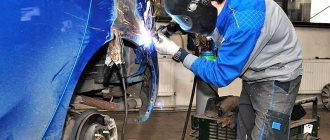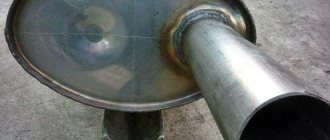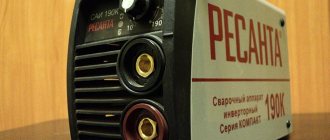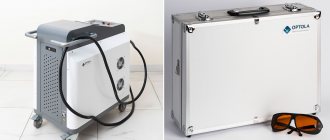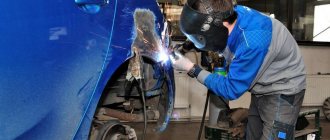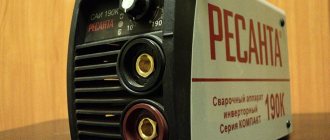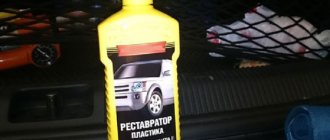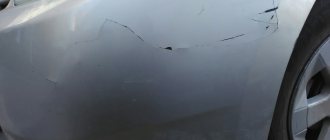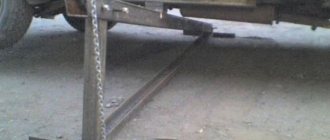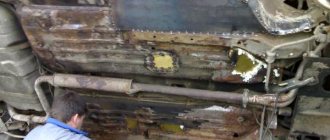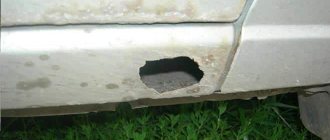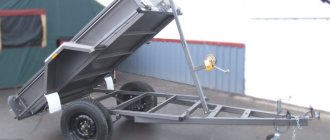Used cars become corroded if not properly cared for. Sometimes, if this problem is not corrected in time, a complete replacement of individual body parts is required. At the same time, welding work cannot be done without. And welding a car body with your own hands requires skills and at least a little experience.
For welding work on a car body, the most acceptable option is to use a semi-automatic welding machine. This allows you to work with any material thickness: from 0.7 to 4 mm. Both, for example, thinner wings and powerful spars fit into this interval.
Methods for connecting elements during automotive welding
Different components and options for car repair using welding require a different approach to pairing new inserts with the old body. Let's look at three main ways to install metal patches.
Butt mate
Welding a car body with a semi-automatic machine is most often carried out using a butt joint. In this way, additional unnecessary thickenings on the body are not created. This method is used when welding patches or small inserts that are not subject to high tensile strength.
Connection types
Before working with the patch, you can chamfer the sides that you plan to weld.
If the sheet thickness is up to 2 mm, then you can do without chamfers. This method of mating requires more painstaking adjustment of the welded part and the prepared area of the car body. Gaps should be kept to a minimum, and ideally, they should be avoided. The method is usually used for external external elements.
When performing this operation, the welder must have sufficiently high qualifications.
Butt welding
The work is carried out using a continuous spot weld. A high-quality result does not require labor-intensive straightening and lengthy cleaning. Sometimes putty and grout are enough. Thicker sheets of iron are easier to weld, and they can also be welded with a continuous spot weld. Thin sheets are more difficult to cook.
Lap joint
This connection is the simplest and therefore has become widespread among automotive welders. So, one of the pieces of metal is superimposed on the other, and the hole that needs to be patched is completely blocked.
Welding overlap
The method is suitable for welding load-bearing structures: thresholds, spars, etc.
Welded electric rivets
This method is rather a type of overlap connection. However, it is similar to spot welding. It is actively used in automotive welding. For example, it is used to install new fenders and reinforcing linings on the body frame.
What can a semi-automatic machine do for welding a car body and more...
Let us repeat once again about the semi-automatic device more specifically, or rather about its capabilities. Semi-automatic welding is the basis of car body repair. Only thanks to the fact that you have a reliable carbon dioxide semi-automatic machine, repairing any car will not seem like a gamble. Whether it’s an old, holey and dead “penny”, which instead of thresholds has only a rusty fringe left, and every second the driver and passengers risk falling out of the cabin through huge holes in the floor, or a pretentious foreign car, flattened by an inattentive blonde in a fatal accident. With the help of a carbon dioxide semi-automatic machine, you will restore any body - weld any patches on any holes, weld in new body parts - fenders, sills, side members, repair inserts, straighten dents that cannot be accessed from the inside, and thereby give the car a new life. In addition to repairing car bodies, a carbon dioxide semi-automatic machine will allow you to solve many other important problems: 1. Repair garden and household equipment by welding 2. Weld water pipes. 3. Make special tools for car repairs - for example, a powerful socket wrench for loosening wheel nuts. 4. Make any metal structures for your garage, for example, shelving from steel profiles.
Types of Welds
Regardless of the joining methods, in each case, semi-automatic welding technology involves the use of different types of seams. There are three popular seam options:
- solid;
- point;
- continuous intermittent.
Types of seams
Each of them can be applied in any of the mating methods, both with overlaps and butt joints.
Seam location
Work can take place in different planes:
- horizontally “welding from above”;
- horizontally “welding from below”;
- vertical seam.
The most convenient option is welding “from above”. In this position, the seam is filled completely, filling all voids and cracks. A less convenient option for vertical work. In this case, it is necessary to ensure that the metal does not flow down the seam.
The most difficult welding method involves “working from below.”
In this position, the seam is formed under the mating elements and constantly tends to flow down. Therefore, you need to have the skill to work in this position so as not to deteriorate the quality of welding.
Technical abbreviations used in welding work
MIG - metal - inert gas (for example, argon). Welding takes place in an inert gas environment that does not interact with the molten metal. MAG - metal - active gas (carbon dioxide). Welding occurs in a shielding gas environment that interacts with the molten metal of the weld. Some clarifications: if you weld with a carbon dioxide semi-automatic device, then this means MAG welding. If you are tired of welding with carbon dioxide, and you connected the same semi-automatic machine to an argon cylinder, then this is already MIG welding. TIG - welding with a non-consumable tungsten electrode in an inert gas environment (usually argon).
Preparing material for welding
Before starting any welding work, you will need to prepare the surfaces. To do this, cleaning is carried out from all types of contaminants:
- traces of corrosion;
- layers of paint and primer, including transportation ones;
- conservation and protective coating layers;
- all types of lubricants.
The presence of such substances can reduce the quality of the applied seam or completely prevent the passage of current through the circuit.
Other negative consequences also occur:
- the gas that is formed when burning flammable residues can create a porous, poor-quality seam structure;
- such gases can “blow” the metal out of the welding point, resulting in a hole, and the molten metal, splashing, can lead to burns;
- pollution emit large amounts of smoke, which can lead to poisoning by combustion products or cause a fire.
The surfaces must fit tightly together.
Safety during operation
Various clamps and clamps are used for this purpose. Temporary fastenings with bolts or self-tapping screws are also allowed.
Carbon dioxide cylinder
There are options here. You can buy a small imported carbon dioxide cylinder, but it is a bit expensive. A more popular case is a standard domestic cylinder with a volume of 40 or 25 liters. Carbon dioxide, or rather carbon dioxide, in cylinders is in a liquid state and occupies a little more than half of their volume. The remaining half contains gas in its natural phase - gaseous.
If welding is not a random episode for you, but a matter of life, buy a small cylinder, 20 liters per liter. Such a cylinder will last for a long time - for a year, or even more, and you can carry it alone. And further. Such a cylinder easily fits in the back seat of almost any car. As for the 45 liter cylinder, it, of course, lasts even longer. But it is too heavy to move quickly. Carrying such a cylinder alone, especially when filled, is very difficult - you can fill it up. All that remains is to slowly roll...
Welding current adjustment
For novice welders who have not worked with thin sheets smaller than 1 mm, it is advisable to practice not on the working surfaces of a car, but to conduct experimental welding of unnecessary thin pieces.
It is necessary to adhere to safety precautions when welding work on a car:
- there is no need to take galvanized specimens as experimental sheets, since the fumes will be poisonous;
- Work cannot be carried out in a strong draft or wind, as this will blow gas out of the welding zone, which will reduce the quality of the work or make it completely impossible.
The amount of welding current is directly dependent on the thickness of the metal. For sheets of small thickness, you will need to set the current in the range of 40-60 A.
Most current regulators on semi-automatic machines do not have absolute graduations, but relative ones. Therefore, the exact current indicator will need to be checked according to the instructions.
The correctness of the selected current will indicate the quality of the weld. Different voltages in the electrical network affect the output parameters of the device. Therefore, setting up the device is carried out to a large extent by experimentally selecting the positions of the adjustment knobs.
What gases are used for semi-automatic welding of a car body?
The main gas used for semi-automatic welding is CO2 (carbon dioxide), also called carbon dioxide, carbonic anhydride. Carbon dioxide is supplied to the welding zone under pressure, displacing the normal air environment, which prevents the metal from excessive oxidation. To be completely honest, oxygen is also released from carbon dioxide in this case, but in much smaller quantities than if welding was carried out without it. Preventing oxidation allows you to save a larger volume of metal that has not turned into oxides (FeO). As a result, the metal does not burn, but only melts, and less slag (oxides) is released.
As a rule, carbon dioxide is obtained from carbon dioxide (GOST 8050 - 76); in fact, it is liquefied gas. Carbon dioxide is stored in special cylinders with a volume of 40 kg, while only 25 kg of carbon dioxide is filled into a cylinder. When evaporating 1 kg of liquid carbon dioxide at 0°C and 760 mm Hg. Art. 506.8 liters of gas are formed, that is, 25 kg of carbon dioxide will amount to 12.67 m3 of gas. But we’ll talk about what cylinders should be for storing carbon dioxide later. Carbon dioxide can be technical or food grade. In principle, any will do, but technical ones contain less water vapor, which is completely useless in the area of the parts being welded. If instead of carbon dioxide you use argon as a protective material, then you can also weld non-ferrous metals - stainless steel, aluminum, brass and other alloys and metals. One obligatory condition is that you use the appropriate welding wire - i.e. made of stainless steel or aluminum. As for non-consumable electrode welding (TIG welding), this type of welding requires more skill and is less convenient for welding body metal. Although, the quality of welding using this method is beyond competition.
Setting up regulators
An example is the semi-automatic device Helvi Panther 132 . It has three regulators that affect the current parameter. The two toggle switches have only two positions: “1” and “2” on the first, “min” and “max” on the second. The third one smoothly regulates the wire feed. And the speed at which the wire is fed depends on the magnitude of the current. This means that the device independently regulates the current depending on the wire feed.
Semi-automatic welding
As an example, we can give the settings of this semi-automatic machine for different thicknesses of the metal being welded. The thin sheet was “cooked” well at the settings: “1”, “max”, and the smooth adjustment was at “7”. It is better to try thick sheets on the setting: “2”, “max”, “8”.
When working with a semi-automatic machine, there may be different welding results. Depending on the current strength, you can get the following results:
The result of welding with different currents
First case
The current is too low, so the metal does not spread over the surface, and the part does not warm up, which worsens the mating. It turns out that there is no “penetration”. You will need to increase the current.
Second case
The current is correctly adjusted, the metal spreads sufficiently and heating of the part being welded is noticeable. A small metal drop is visible on the back of the sheet.
Third case
The current is greater than the permissible value. The molten drop from the wire has sank too much. On the other side there is an obvious large drop of molten metal.
Fourth case
A significant excess of the permissible current to such an extent that through burns are formed. A significant reduction in current is required until a small drop appears without burning.
Possible problems when operating a semi-automatic welding machine
Not all work is carried out as usual. Unusual situations may occur due to operational errors or faulty equipment.
Incorrect current selection
When the current is set too high, burns form in the metal. There may also be a drop of melted wire that protrudes from the copper tip. If such a situation occurs, then additional wire feeding may lead to a break when it exits the feeder.
Poor pressure adjustment in the feed mechanism
If the passage of the wire through the copper tip is blocked, then it breaks down in the feeding mechanism. This indicates too much clamping force. When adjusted correctly, the wire will slip rather than break. This event indicates the opposite - the clamping force does not sufficiently fix the wire.
In this case, “sticking” may occur in the tip, and not be related to the value of the set current.
The same results occur when the wire feed is too slow.
